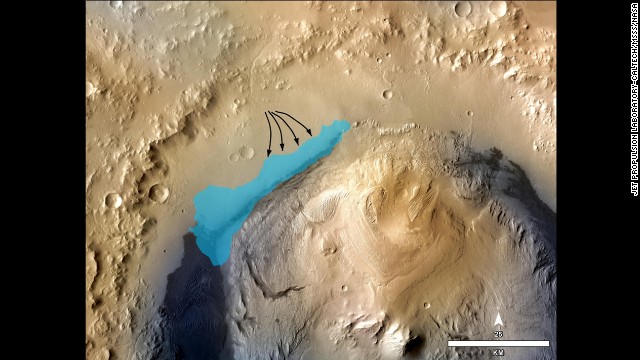
(CNN) -- Curious about life on Mars? NASA's rover Curiosity has now given scientists the strongest evidence to date that the environment on the Red Planet could have supported life billions of years ago.
Since Curiosity made its rock star landing more than a year ago
at Gale Crater, the focal point of its mission, the roving laboratory
has collected evidence that gives new insights into Mars' past
environment.
NASA scientists announced in March that Mars could have once hosted life
-- at least, in the distant past, based on the chemical analysis of
powder collected from Curiosity's drill. An area of the crater known as
Yellowknife Bay once hosted "slightly salty liquid water," Michael
Meyer, lead scientist for the Mars Exploration Program at NASA
headquarters in Washington, said earlier this year.
Six new studies
released Monday by the journal Science add more insights about these
formerly habitable conditions and provide other new knowledge that
increase our understanding of the Red Planet. The results were also
presented at the fall meeting of the American Geophysical Union in San
Francisco.
Curiosity found evidence
of clay formations, or "mudstone," in Yellowstone Bay, scientists said
Monday. Martian mud is a big deal because this clay may have held the
key ingredients for life billions of years ago. It means a lake must
have existed in this area.
"This is a game changer
since these are the kind of materials that are very 'Earth-like' and
conducive for life," said Douglas Ming, lead author of one of the new
studies.
This ancient environment, where the clay minerals formed, would have been favorable to microbes, Ming told CNN.
Some bacteria on Earth
called chemolithoautotrophs could have lived in that kind of
environment. These bacteria derive their energy from breaking down rocks
and sediments, Ming said, generally by oxidizing elements in the rock.
Ming and colleagues also
found hydrogen, oxygen, carbon, nitrogen, sulfur and phosphorus in the
sedimentary rocks at Yellowknife Bay, elements that are all critical for
life.
The new findings mean
the rover's $2.5 billion mission is "turning the corner," said John
Grotzinger, a California Institute of Technology planetary geologist and
chief scientist for Curiosity, also known as the Mars Science
Laboratory.
Grotzinger and
colleagues found the habitable environment existed later in Martian
history than previously thought. By studying physical characteristics of
rock layers in and near Yellowknife Bay, they determined that Mars was
habitable less than 4 billion years ago -- about the same time as the
oldest signs we have for life on Earth.
The habitable conditions
could have remained for millions to tens of millions of years, with
rivers and lakes appearing and disappearing over time.
Curiosity also helped
scientists figure out the age of an ancient Martian rock, as described
in the new research. The rock is called Cumberland, and it now has the
distinction of being the first whose age was measured on another planet
through chemical analysis.
The rover used a method
for dating Earth rocks that measures the decay of an isotope of
potassium as it slowly changes into argon. Scientists determined the
rock was between 3.86 billion and 4.56 billion years old. This age range
is consistent with earlier estimates for rocks in Gale Crater.
Scientists say roughly 4
billion years ago, the environment on Mars wasn't much different from
that of modern-day Earth. But things on Mars then took a drastic turn,
and the planet was dramatically transformed from warm and wet to
bitterly cold and dry, scientists say. In addition to the cold and dry
conditions, scientists say the No. 1 reason life probably wouldn't have
thrived on Mars is its extremely high levels of radiation.
"The radiation
environment on Mars is unlike anything we have on Earth," said Jennifer
Eigenbrode, a biogeochemist and geologist at NASA's Goddard Space Flight
Center and an author of one of the studies. "We don't know if life on
Mars could have ever adapted to the high levels of radiation the surface
is currently experiencing."
Eigenbrode added, "This is a wide-open book, which we have barely started writing the pages of."
New radiation measurements will also be important to planning any human missions to Mars, scientists said.
"Our measurements also
tie into Curiosity's investigations about habitability," study co-author
Don Hassler of Southwest Research Institute in Boulder, Colorado, said
in a statement. "The radiation sources that are concerns for human
health also affect microbial survival as well as preservation of organic
chemicals."
Organic chemicals come from a variety of sources, including meteorites and comets, but they can also be indicative of life.
What's bad for us is bad for signs of life -- but these organic chemicals could still be hiding on Mars nonetheless.